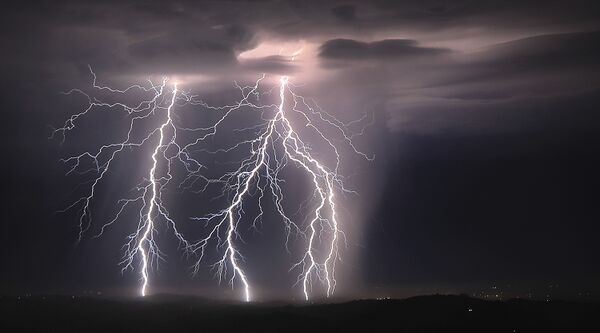The official discord link if you wish to join the discord: https://discord.gg/j5RKwCvAFu
Support the wiki on our official Ko-Fi page or Patreon page!
Lightning Standards

Introduction
In fiction, a common form of elemental attacks are electricity/lightning based ones. Lightning is a giant spark of electricity in the atmosphere between clouds, the air, or the ground. In the early stages of development, air acts as an insulator between the positive and negative charges in the cloud and between the cloud and the ground. When the opposite charges build up enough, this insulating capacity of the air breaks down and there is a rapid discharge of electricity that we know as lightning. The flash of lightning temporarily equalizes the charged regions in the atmosphere until the opposite charges build up again. Lightning can occur between opposite charges within the thunderstorm cloud (intra-cloud lightning) or between opposite charges in the cloud and on the ground (cloud-to-ground lightning). Lightning is one of the oldest observed natural phenomena on earth. It can be seen in volcanic eruptions, extremely intense forest fires, surface nuclear detonations, heavy snowstorms, in large hurricanes, and obviously, thunderstorms.
Lightning Dodging
Scientific basis
The speed of lightning can vary mostly in the range of 1.0-14×105 m/s. For the purpose of calculating speed feats we use the average lightning speed of 4.4×105 m/s (Mach 1294), which is suggested by this study. Similar studies have found average speeds within the same order of magnitude, albeit lower. [1][2][3]
The clouds that usually cause thunderstorms build about 200m to 4000m above the ground.[4] In this wiki, 2000m is the standard assumption. However, this is only for cases of cloud to ground lightning, lightning in the air has no consistent form of travel and thus cannot be used for speed[5].
Calculation
The calculation for the speed a character moves at when dodging/reacting to lightning is a very simple one.
The formula is: (Distance the character moved in m * speed of lightning in m/s)/(Distance the lightning moved in conjunction to when the character started moving)
Cloud-to-Ground lightning
Based on the formula and scientific basis we can now make an estimation on which speed characters, that dodged cloud-to-ground lightning, should be placed at. We do that by inserting the distance values and the speed values into the formula. For the distance the character moved we will assume one meter, as that seems reasonable without further information. Should a character appear to have moved a lot more or a lot less than this, a separate calculation has to be made using the formula above.
| Speed\Distance | Low-End (4000m) | Average (2100 m) | High-End (200m) |
|---|---|---|---|
| Low-End | |||
| Average (4.4×105 m/s) | |||
| High-End |
Non-Cloud-to-Ground lightning
The speed of lightning that's not cloud to ground is unknown currently in the general field of science and thus not usable for speed tiering.
Energy
The energy of electricity can directly be calculated if its current and electrical potential difference is known.
If the current is a ampere and the electrical potential difference is v volt, then the power of the lightning is given as a*v J/s. Usually 1 second of this is addressed to the AP, unless the electrical flow couldn't be sustained for that long.
It should be noted that for real electricity enduring a lightning strike usually doesn't require durability equal to the lightnings full energy. There are two reasons for that:
- The lightning will usually take only a certain path through the body. Along that path there can be strong burns, but the rest can be largely unaffected.
- The lightning doesn't discharge its entire energy in the human body. It will usually also heat up the air and pass on into the ground where its energy disperses. The amount of energy lightning produces in form of heat when flowing through is largely determined by the objects electrical resistance.
Due to this, and possibly other factors, it is for example possible for humans to survive being hit by lightning, even though an average normal lightning contains approximately 1.6 billion Joules. The energy of secondary effects that lightning might cause, can in some cases fully apply on the other hand.
References
- ↑ http://es.vaisala.com/Vaisala%20Documents/Scientific%20papers/2.Campos,%20Saba,%20Warner.pdf
- ↑ http://citeseerx.ist.psu.edu/viewdoc/download;jsessionid=D4862F763A4196979F07E07DA6B89E01?doi=10.1.1.589.8160&rep=rep1&type=pdf
- ↑ https://arxiv.org/ftp/arxiv/papers/1412/1412.3537.pdf
- ↑ wikipedia:Cumulonimbus cloud#Appearance
- ↑ In general, lightning travels at a speed of about 227,000,000 mph (365,321,088 kmh), which is about 3,700 times the speed of sound. However, this speed can vary depending on the conditions of the atmosphere and the type of lightning. For example, cloud-to-ground lightning typically travels at a slightly slower speed than in-cloud lightning, because it has to travel through the atmosphere before reaching the ground.
